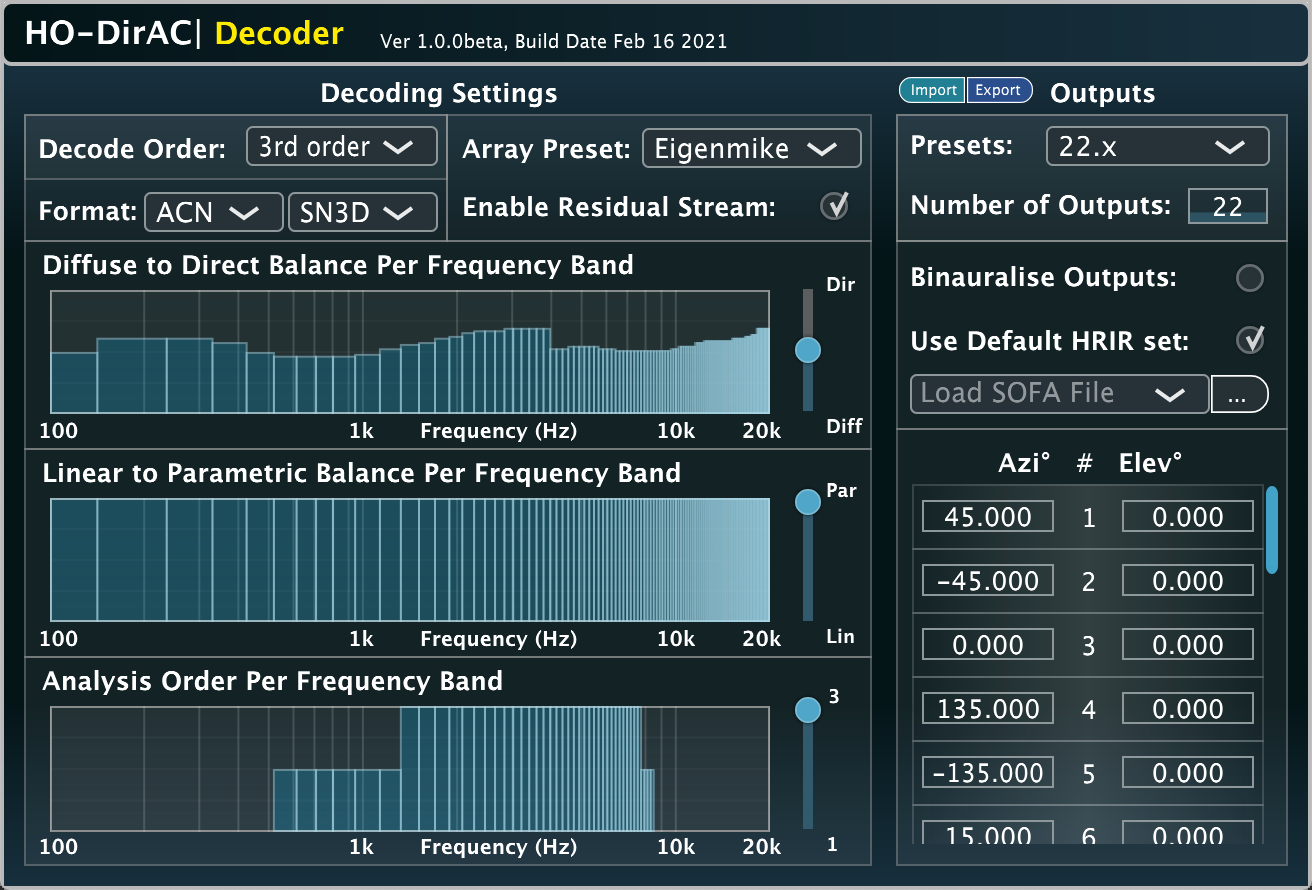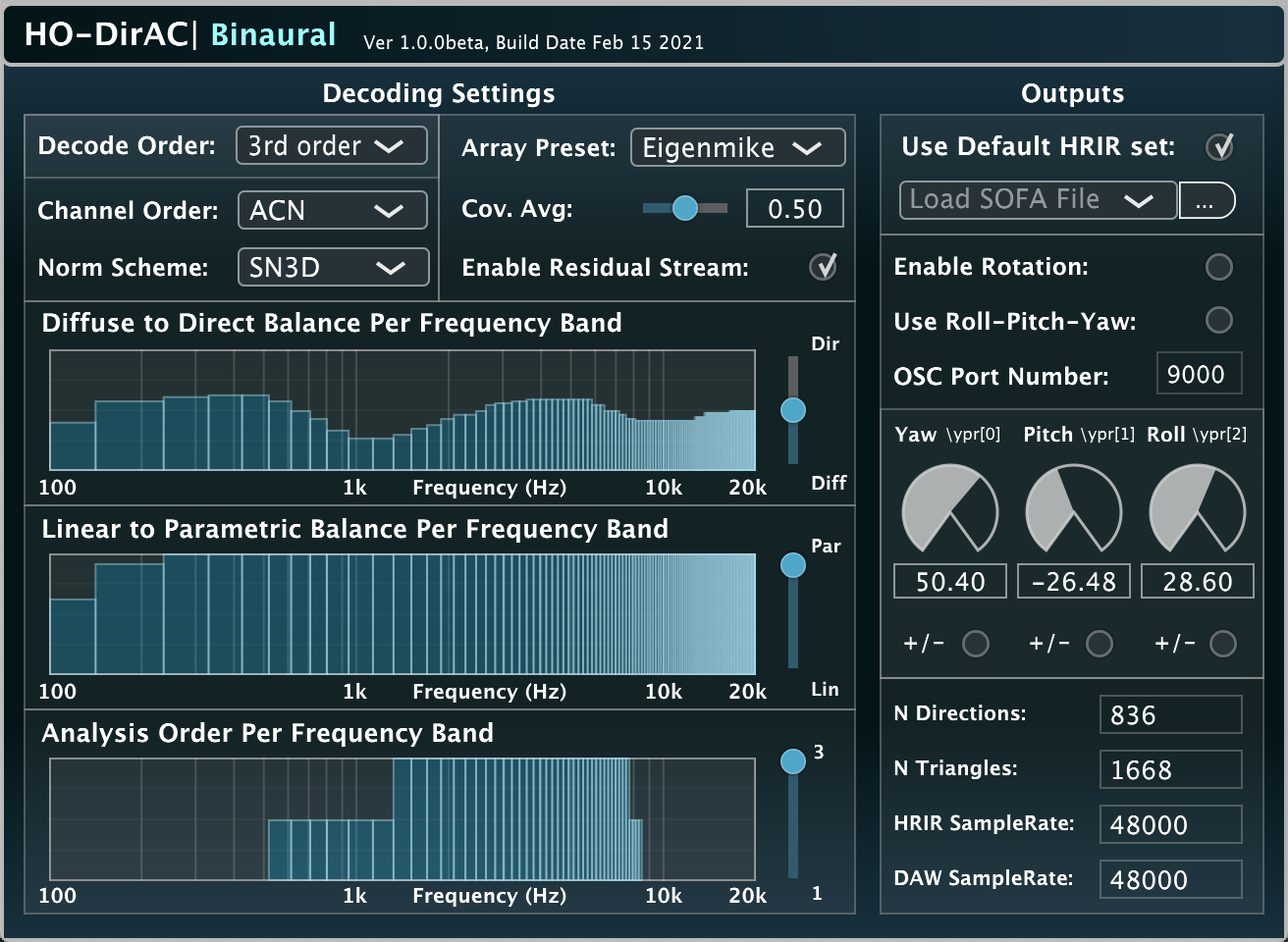HO-DirAC
Plug-in descriptions for the HO-DirAC suite.
Plug-in descriptions
Directional Audio Coding (DirAC) has been an active research topic at Aalto University since 2007 [1]. The method operates by estimating spatial parameters to describe the input sound scene over time and frequency, which are then used to conduct the mapping of the input Ambisonic signals to the output loudspeaker/binaural channels in an adaptive and informed manner. While the original intention of DirAC was for low bitrate compression and transmission of Ambisonic recordings, more recent years have instead focussed on using it for the enhancement of Ambisonics reproduction.
These particular audio plug-in implementations use the higher-order analysis designs described in [2,3], which synthesise the target output signals based on the optimal covariance domain rendering framework described in [4].
All plug-ins conform to the Ambisonic Channel Number (ACN) ordering convention and offer support for both orthonormalised (N3D) and semi-normalised (SN3D) scalings (note: AmbiX uses ACN/SN3D). The maximum Ambisonic order for these plug-ins is 3.
Decoder

This plug-in is based on the design detailed in this publication.
An Ambisonic loudspeaker decoder based on the Higher-order Directional Audio Coding (HO-DirAC) method.
The plugin first generates intermediate (prototype) loudspeaker signals to serve as a good “starting guess”. In this case the Energy-Preserving Ambisonic decoder (EPAD) is used (as found in sparta_ambiDEC). The signal statistics (covariance matrices per frequency band) of these prototype loudspeaker signals are then computed, followed by defining new target covariance matrices that are formed based on the analysed spatial parameters. The problem of applying mixing matrices to the prototype signals such that their narrow-band covariance matrices are brought closer to the target covariance matrices, is then solved by using the covariance-domain framework for spatial audio processing (CDF4SAP); also referred to as “optimal-mixing”. The approach aims to synthesise signals that exhibit the target covariance matrices first via a linear combination of them as much as possible, followed by “filling in the gaps” with a decorrelated version of the prototype signals; as described by a residual mixing matrix. Such processing aims to improve signal fidelity and also mitigate artefacts arrising due to signal decorrelation. Depending on the scene, and as the number of input channels exceed the number of output channels, the decorrelated signal energy can become negligible. This can be demonstated by using the “Enable Residual Stream” toggle button, when rendering such scenes.
The “Diffuse-to-Direct” control allows the user to give more prominence to the direct sound components (an effect similar to de-reverberation), or to the ambient component (an effect similar to emphasising reverberation in the recording), while the “Linear-to-Parametric” control lets you control the balance between HO-DirAC decoding and EPAD decoding. When using Ambisonic signals derived from microphone arrays, the frequency ranges at which higher-order components can be obtained varies depending on the order; in these cases, the “Analysis-order” may be specified per frequency band to account for these inperfect input Ambisonic signals.
The plug-in is considered by the authors a production tool and, due to its time-frequency processing, requires internal audio buffer sizes of at least 2048 samples. Hence we do not consider it as a low-latency plug-in and therefore it is not suitable for interactive input. For cases such as interactive binaural rendering for VR with head-tracking, refer to the HO-DirAC|Binaural version.
Binaural

This plug-in is based on the design detailed this publication.
This is an optimised version of the HO-DirAC decoder for binaural playback, which bypasses loudspeaker rendering by using binaural filters (HRTFs) directly, which can be user-provided and personalised with the SOFA format. For the plugin parameters, see the description of the HO-DirAC|Decoder above. Additionally the plugin can receive OSC rotation angles from a headtracker at a user specified port, in the yaw-pitch-roll convention.
This version is intended mostly for head-tracked binaural playback of Ambisonic content at interactive update rates, usually in conjunction with a head-mounted display (HMD). The plugin requires an audio buffer size of at least 512 samples (~10msec at 48kHz). The averaging parameters can be used to make the parametric analysis and synthesis more or less responsive, providing the user with a means to adjust them optimally for a particular sound scene.
Upmixer

This plugin is intended for the task of upmixing a lower-order Ambisonic recording to a higher-order Ambisonic recording. It is essentially a wrapper for HO-DirAC|Decoder, as it first decodes the input to an appropriate uniform arrangement of virtual loudspeakers (e.g. a t-design) followed by re-encoding the virtual loudspeaker signals into the target order. It can be used by users who are already working with a preferred linear Ambisonic decoding workflow of higher-order Ambisonic content, and wish to combine lower-order Ambisonic material with increased spatial resolution. One can upmix first, second, or third-order material (4,9,16 channels) to up-to seventh-order material (64 channels).
About the developers
These plug-ins were developed by Leo McCormack. However, a number of people were involved in the research of the employed algorithms, and much of the internal C/C++ code is also based on Matlab code written by Archontis Politis and Juha Vilkamo; who, in turn, based their code and research on the code and research of: Mikko-Ville Laitinen, Jukka Ahonen, Tapani Pihlajamäki, and Ville Pulkki. For a detailed history, and for descriptions of both legacy and modern DirAC processing, the reader is referred to [5].
License
These VST/LV2 plug-ins, which incorporate Aalto University’s implementation of the DirAC technology, are provided for academic, personal and/or non-commercial use by a non-enterprise end-user. Any exploitation of the plug-ins for other purposes may require a license from Fraunhofer IIS. For commercial implementations of DirAC technology, the user is instead referred to upHear.
References
[1] Pulkki, V. (2007) Spatial sound reproduction with directional audio coding.
Journal of the Audio Engineering Society 55.6: 503-516.
[2] Politis, A., Vilkamo, J., and Pulkki, V. (2015). Sector-based parametric sound field reproduction in the spherical harmonic domain.
IEEE Journal of Selected Topics in Signal Processing, 9(5), 852-866.
[3] Politis, A., McCormack, L., and Pulkki, V. (2017, October). Enhancement of ambisonic binaural reproduction using directional audio coding with optimal adaptive mixing.
In 2017 IEEE Workshop on Applications of Signal Processing to Audio and Acoustics (WASPAA) (pp. 379-383). IEEE.
[4] Vilkamo, J., Bäckström, T., and Kuntz, A. (2013). Optimized covariance domain framework for time-frequency processing of spatial audio.
Journal of the Audio Engineering Society, 61(6), 403-411.
[5] Pulkki, V., Delikaris-Manias, S., and Politis, A. (Eds.). (2018). Parametric time-frequency domain spatial audio.
John Wiley and Sons, Incorporated.